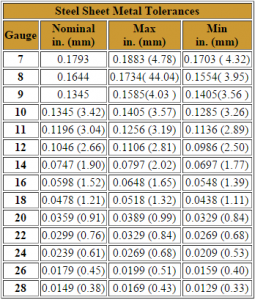- Products
- Industries
- Project Gallery
- Resource Center
- Metal Institute
- Services
- Shop
- Contact Us
January 6, 2015
by Amy Crenan
It is an industry standard that we use the word “gauge” to describe the thickness of steel coils and sheets. Metal roof and wall panels rolled from coil come in a range of gauges, with many of our panels’ standard being 24 gauge. This format is based on the Manufacturer’s Standard Gauge (MSG) which is a remnant of an outdated standard. It’s not until you take a closer look do you realize that specific gauges, such as 24, can equal a range of thicknesses.
When steel coils were rolled decades ago, manufacturers lacked the technology to consistently produce material thicknesses to the tolerances regularly achieved today. Therefore, a relatively large tolerance range was established for the MSG system and this tolerance determines what range of thicknesses qualifies as a particular gauge. For example, as you can see in the table below, 24-gauge panels can range from 0.0269-0.0209 inches.

As time went by and technology improved, coil manufacturers could produce material down to the thousandth of an inch of thickness, and the MSG system was considered outdated by many in the industry. Instead, the Standard Decimal System was introduced. This system defines gauges by specific minimum thickness expressed in decimal numbers instead of a range, eliminating the tolerance. Although widely accepted throughout the industry, the architectural community has been reluctant to adopt this system when specifying building products.
Because the architectural community is still specifying buildings using the MSG system, manufacturers still list their products by it as well. This leads to some manufacturers taking advantage of the MSG system’s large tolerance and producing panels with the minimal thickness allowed to qualify for that gauge. For 24-gauge panels, for example, they might roll it to 0.0209 inches, instead of the nominal 0.0239 inches. Although still technically allowed it seems misleading to me, especially when you consider other manufacturers who spend more money to achieve the specific gauge advertised true to the intent of the MSG system. In addition, this difference in thickness, even in the thousandths decimal place, leads to a difference in structural performance and strength. This can potentially lead to inaccuracies in architects’ specifications or even worse, under expected performance. That said, I think it’s worth the extra effort to take a closer look before selecting products and that it is the manufacturers’ responsibility to present their products honestly.